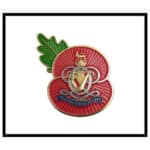Burma 1942
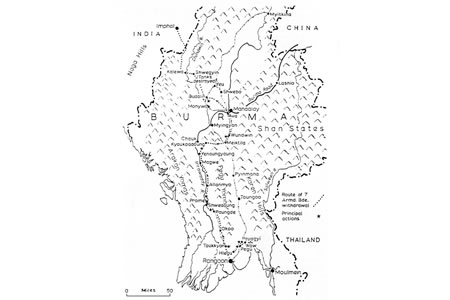
Arrival at Rangoon – 21 Feb 1942.
The 7th Hussars were the only British cavalry Regiment to fight in Burma, and landed with the 7th Armoured Brigade on 21 February 1942 at Rangoon.
The situation was desperate and the 7th Hussars moved straight up to Pegu to fight the marauding Japanese.
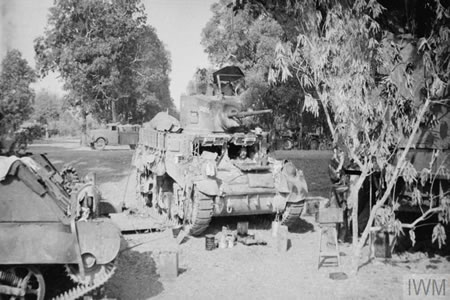
The Battle of Pegu – 3-7 Mar 1942
The Battle of Pegu was all about the defence of Rangoon.
With the 17th Infantry Division decimated and scattered, the forces available for the whole of Burma were the 1st Burma Division and the 7th Armoured Brigade. The British commanders had already decided not to contest Rangoon, but their new strategy relied on convincing the Japanese that Rangoon would be heavily defended.
About midday on the 8th of March Japanese forces entered Rangoon to find to its surprise that the city was unoccupied and deserted. General Sakurai immediately ordered it to pursue the British column which he now realised was the whole of the British forces from the Rangoon area. It was too late and the golden opportunity of destroying the British garrison was lost.
On leaving the area of Rangoon, ‘B’ Squadron, 7th Hussars, arrived in the village of Payagyi to find the Japanese already there. The visibility was poor, and radio communication difficult. After a brief infantry engagement, the 7th Hussars Stuart light tanks opened fire, destroying two Type 95 Ha-Go Japanese tanks. A confused battle ensued, in which two more Type 95s were destroyed, another Type 95 was abandoned by its crew, and four Japanese anti-tank guns captured.
Elsewhere Colonel Fosdick, Commanding the 7th Hussars, had his Stuart tank hit by anti-tank fire which blew off a track, and a ‘B’ Squadron tank was also hit and disabled. One Troop from ‘B’ Squadron was send to assist 7th Hussars RHQ, but all three tanks were hit repeatedly by four anti-tank guns man-handled into position in the night. Soon three more Type 95 Japanese tanks approached and were engaged by two Troops from 7th Hussars in hull-down positions. Two of the Type 95s were knocked out at 1,000 yards range and the third abandoned by its crew.
The 7th Hussars were ordered to retire through Pegu to rejoin the rest of 7th Armoured Brigade at Hiegu. When they arrived in the town as darkness was falling. The town had been severely bombed and the whole place was blazing from end to end and were lucky to still find the only bridge standing. Meanwhile the enemy had erected a road block three miles south west of the town and 7th Hussars halted while ‘A’ Squadron moved down to the block to ascertain its strength. It was apparent that it was quite impossible to get through and probes were made in various directions to get round the flanks, yield not alternative routes.
Hlegu was also in Japanese hands as the British approached. The Japanese had erected a roadblock, and they defended it with molotov cocktails, knocking out one of the tanks. In the end, they were forced to retreat in the face of heavy fire from the tanks.
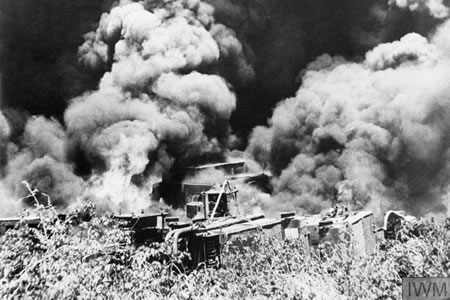
Battle of Paungde – 28-9 Mar 1942
After occupying Rangoon on 8th of March, the Japanese 15th Army rapidly advanced northward. Their immediate objectives were to take the Yenangyuang oilfields, located in the Irrawaddy River valley, 250 miles north of Rangoon.
Situated in the Irrawaddy valley nearly halfway between Rangoon and Yenangyuang is the town of Paungde. By late March Allied forces had retreated to a defensive line stretching from Paungde to Toungoo, approximately 80 miles northeast of Paungde.
On the 27th of March, advance elements of the Japanese 33rd Division arrived in the Paungde sector. The action around Paungde was fierce and lasted two day; Allied casualties were high. On the 30th of March the Allies were forced to fall back towards Yenangyuang.
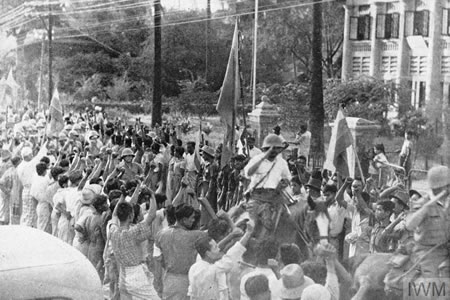
The Retreat to India – 26 Apr 1942
The Japanese started a major attack against the British on the 1st of April near Prome, some 200 miles north of Rangoon.
On April 2nd, the Japanese commander, General Iida, established his headquarters at Toungoo deep in the heart of Burma. Here they found that the bridge over the River Sittang had not been destroyed so that gave the Japanese an advantage with regards to moving their men and equipment.
As the Japanese pressed on, General Alexander decided that the British, Burmese and Chinese armies had to make a stand, which they did near Mandalay. Fierce fighting held up the Japanese but it could not alter the final outcome. General Alexander made the decision on the 26th of April to withdraw all men to India.
At the start of May 1942 when they crossed the river Chindwin, the 7th Hussars had to destroy their remaining tanks, they then became pedestrians for the final 150 miles of the retreat.
On the 15th of May, it started to rain hard. For the British and their allies this was a mixed blessing. It brought further discomfort to the troops but it also greatly hindered the advance of the Japanese who relied on transport to advance their men at speed – something they could not do if the roads/tracks were churned up.
Finally, on the 17th of May the remnants of the division staggered into Imphal. The 7th Hussars had covered nearly one thousand miles in three and half months losing forty six killed and fifty wounded, and earning the highest regard from all who had met them.

